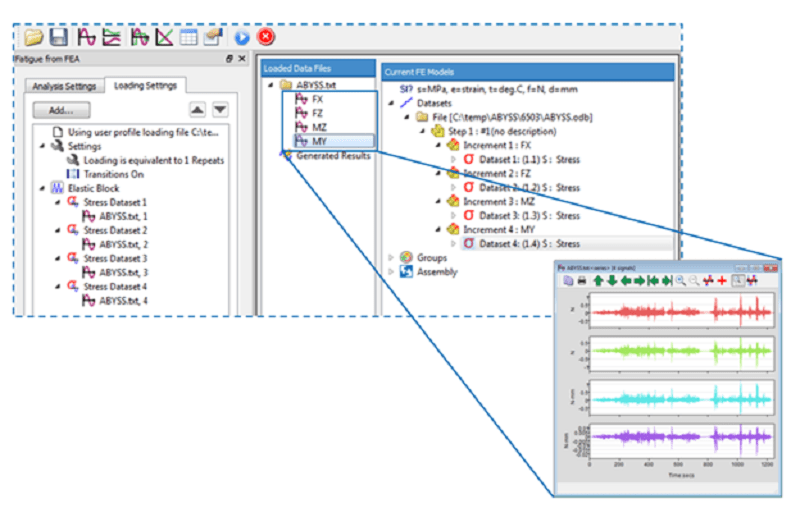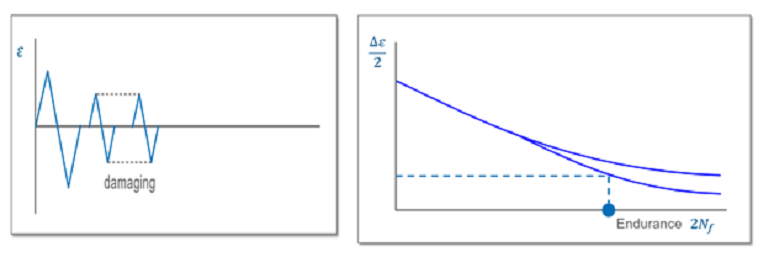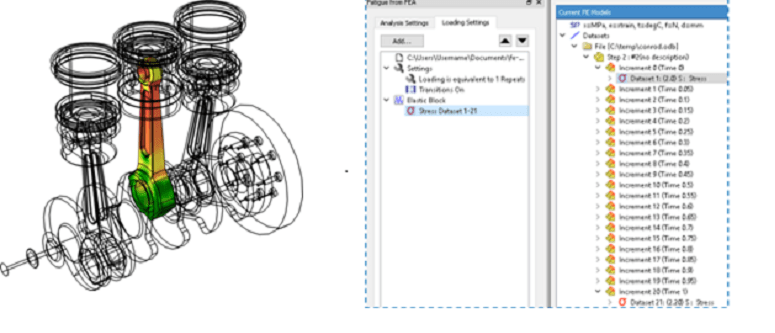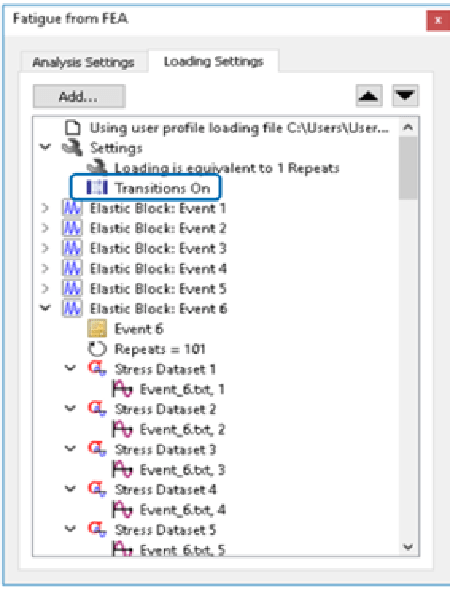
It does not make sense to debate who among these is getting his muscles stretched the most and who is likely to fail first under fatigue. That’s because we have a world class FEA solution to do that for us. The idea behind showing these characters is to realize that it is difficult to analytically predict the location and severity of damage based on the application of load. Moreover, there can be infinite ways loads can be applied in real life so a robust fatigue solution should have a strong toolbox for different loading scenarios.
Let’s call these Hercules Mr. X, Mr. Y, Mr. Z and Mr. W from left to right. Mr. X is carrying multiple loads at the same time while Mr. Y, Mr. Z and Mr. W are carrying a single load. Mr. Z has a unique situation in which the loads are all compressive from the top on a single hand. Mr. W’s pain can be realized well in the image, and he is caught up with loads applied on his hands while all the damage happens on his lower back. Mr. X is carrying the heaviest load, but he may not be the first one to fatigue as loads are evenly distributed all over his back. The more we think who will knock out first, the more we get puzzled.
Engineers who design products and are responsible for sticking a warranty label on their products are in a similar situation, except those who use SIMULIA durability solutions for life cycle and damage estimations. While there are many challenges in performing an accurate durability simulation, in this blog we are solely focusing on the different loading scenarios and how to capture them in Fe-Safe.
Different Loading Scenarios in Durability
The loading scenario includes the nature of the load itself and its application. The load can be either a constant amplitude or a variable amplitude load. For example, load generated from the motion of crankshaft is constant amplitude while one from potholes on a rough road is a variable amplitude load.

As discussed earlier, there can be a few loads all acting at the same time, either at same location or at multiple locations. If the model is nonlinear then the loading scenario must be addressed in the corresponding finite element analysis. However, in the case of linear models, it makes sense to perform unit load FEA’s separately and scale and combine the loads for durability. Fe-Safe has the capability to combine loads from individual loads.

Rainflow Algorithm: Fatigue is always calculated in number of cycles as each cycle has a damage associated with it that accumulates. The big question next is how to calculate the number of cycles of a variable amplitude load! It appears so noisy. The answer is the industry proven Rainflow counting method that can compute effective number of cycles of a variable loading.
Moreover, variable loads with less than endurance limit can cause fatigue as well. Fe-Safe addresses this strange but real physical behavior by modifying the S-N curve in case of variable amplitude. In real life most damage comes from the load amplitudes below the endurance limit because of variable amplitude loading.

Nonlinear Durability modeling in Fe-Safe
Recalling that there are three broad types of Nonlinearities: Geometric, Material and Contact. In either of these cases, superposition of loads approach does not work. While Fe-Safe is still the best candidate in the market to address Nonlinear durability cases, a competitive Nonlinear FEA solver is required as well to get correct stresses. That solver is Abaqus of course.
The simplest situation is Nonlinear geometry as in large deformation. A common example is crankshaft moving through piston firing (assuming no creep and thermal fatigue). In large motion problems unit load and superposition does not work. The entire motion stress analysis should be done in Nonlinear FEA first. Later Fe-Safe should be fed with sequence of stress datasets.

The next Nonlinear aspect is the material. The local plasticity is easy to address in Fe-Safe using the Neuber’s Plasticity correction. Nothing needs to be changed in the FEA model. Global plasticity requires a Nonlinear material definition in FEA model. The Fe-Safe requires both stress as well as strain inputs from the FEA analysis results. Full plasticity events are usually very low cycle and high amplitude in nature such as thermomechanical and elastomer fatigue.
Multi Block Loadings
Many real life loading scenarios are sequential in nature in which fatigue events are chained one after the other. It’s more common in transportation and mobility industry. Take the example of a car driven for 100 miles on different types of terrains. Each terrain has its own roads characterized by type of gravel used, potholes, speed breakers etc. In Fe-Safe sense each terrain has its own variable load signals in three-Dimensional space.
Fatigue analysis of such a multi event scenario required multi block loading method available in Fe-Safe. Each block has its own variable load signals associated with a unit load stress tensors in respective directions. These blocks are stacked one over the other. If sequencing matters, it can be considered. Fe-Safe can calculate total fatigue life of the event as well as damage done per block to give more insight on damaging cycles. In case of Nonlinearity the variable load signals in each block are replaced by stress-strain datasets.

Fe-Safe is a very comprehensive fatigue code. There are many advanced loading scenarios available such as combination of high cycle and low cycle loads, Noise and vibration-based fatigue including PSD.

